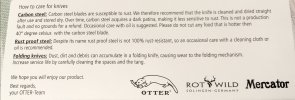Alex.Y.
Gold Member
- Joined
- Jan 11, 2021
- Messages
- 1,826
I haven't found any alive and appropriate thread for this, so here it comes.
Going through knife boxes I found this Otter's knife care note:

"Please do not cut any food that is hotter than 40 degree Celsius with the carbon steel blade."
What is going to happen? Why 40 degree? And how am I supposed to determine the food's temperature, stick a thermometer in it?
Going through knife boxes I found this Otter's knife care note:

"Please do not cut any food that is hotter than 40 degree Celsius with the carbon steel blade."
What is going to happen? Why 40 degree? And how am I supposed to determine the food's temperature, stick a thermometer in it?




